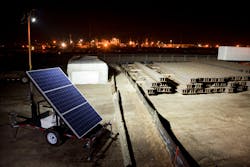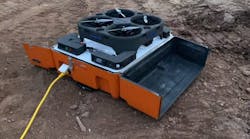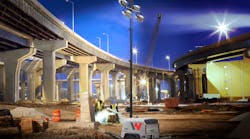Manufacturers offer various light towers with options that allow workers to select exactly what they need, regardless of the job site. In recent years, technology has shifted the market toward towers that are more environmentally friendly, safe, and provide a greater return on investment. End users also aim to maximize their run time, so the longer the light tower can run before refueling, the better.
One of the most prominent trends within the light tower industry today is the shift from metal halide lamps to LED lighting. Although customers have been slow to adopt light towers with LED bulbs, in recent years, several have begun to request them.
Although manufacturers agree that LED light towers have several advantages over the metal halide light towers, Eric Massinon, business development manager at Chicago Pneumatic, says the greatest advantage is fuel efficiency. Since LEDs require less power than metal halide lights, they produce better fuel economy, making the total cost of ownership much lower.
Cost of ownership benefits
According to Erin Brown, Doosan Portable Power’s senior product specialist, customers would see a return on their investment between six months and one year after switching from metal halide to LEDs.
“That’s where the payback comes in,” she says. “LEDs use half of the fuel. They’re more expensive, but the payback to the end user is the amount of fuel required to operate the light tower.”
To put the differences into perspective, Massinon says Chicago Pneumatic offers a 6kW light tower with a 28-gallon fuel tank, providing 4,000 watts of metal halide lighting for 50 hours. However, after switching the metal halide bulbs out for LEDs, the tower runs for 150 hours.
“It’s the same 28-gallon fuel tank, but with three times the runtime,” Massinon says.
A metal halide bulb has to reach several thousands of degrees in temperature before it can operate—meaning it can take up to 15 minutes to reach full power. LED bulbs, on the other hand, do not require intense heat to function. They can be switched on and off instantly, providing customers with a more time-efficient lighting solution.
“Metal halide lights take a while to warm up to be at full brightness,” Massinon says. “When you shut them off, users have to wait for the lights to cool down—sometimes up to 10 minutes before you can turn them back on.”
Massinon says if metal halide bulbs haven’t cooled down before the tower is moved, they become more susceptible to breaking.
“Metal halide bulbs in stationary applications can last 6,000 hours or more,” he says. “But with portable light towers, because the heat weakens the bulb, their life expectancy is usually much lower depending on how the tower is treated. There’s no way of telling how long they will last.”
An LED bulb typically guarantees 10,000 hours of use at its full light output, whereas metal halide bulbs lose 50 percent of their light output within the same timeframe.
Brown expects all light towers to come with LED lights within three to five years. Doosan Portable Power currently sells 70 to 80 percent of its light towers with LED fixtures, she says.
Manufacturers are also developing systems to increase safety when operating light towers. Atlas Copco’s “SmartMast,” for example, adjusts mast height on a hydraulic-mast light tower based on job site conditions. The system uses sensors to monitor external stress to determine how high a mast should stand without endangering the work site.
“SmartMast will lower in case of high wind or any dangerous situation,” Angel Nieto, power and light product manager at Atlas Copco says. “Depending on environmental conditions, the mast will lower to the level it considers safe, and raise again when conditions have improved.”
SmartMast will assess whether the surface is level enough to keep the light tower stable. If it detects an unstable surface, the system will prevent the tower from operating. The mast will also lower if an obstacle is closer than a foot above it, and will alert users if an object approaches that might impact the tower.
Light towers with solar, battery options
Manufacturers are also developing battery- and solar-powered light towers to help reduce environmental impact on a job site.
Atlas Copco’s first battery-powered light tower, the HiLight Z3+, is powered entirely by a lithium-ion battery and charges directly from a grid or portable generator supply units, meaning it produces zero emissions and uses zero fuel.
“One customer wanted to avoid any spillage or fuel leaks in the location where they were running these light towers,” Nieto says. “So they were interested in something like this, where there would be no risk at all that there was any fuel or diesel on the ground.”
The tower also runs silently, helping to prevent noise pollution on site.
Solar-powered light towers do not leave a carbon footprint because they recharge by capturing sunlight with maneuverable solar panels and storing electricity in a heavy-duty battery.
“Solar-powered light towers are best for use in remote places that are difficult to get trucks to for refueling,” says Jeff Hock, Wanco’s VP of operations. “If you have solar panels to capture the sun, the unit will keep going for a long time without having to worry about getting fuel trucks to do oil changes or maintenance.”
Most solar light towers operate by photocell—sensors that detect light and enable towers to turn on and off autonomously.
“A lot of the time, you can set it and forget it,” Hock says. “Most solar towers come on automatically and go off when the sun rises. There’s no operator that has to come up to it and turn it on and off.”
Hybrid light towers feature solar panels and a backup diesel generator. Once the battery pack’s stored solar energy runs out, the diesel backup generator will automatically start. This helps continuously provide the energy to power the lamps, while simultaneously recharging the battery pack. When the battery is fully recharged, the generator will automatically turn off.
Innovations within the light tower segment have given end users more opportunities to create a safer, efficient worksite. As technology improves, manufacturers will continue to shift offerings toward more modernized options.





